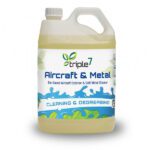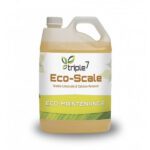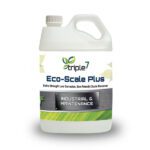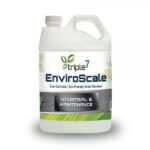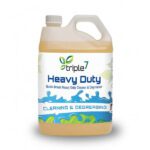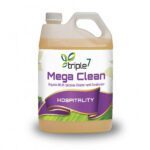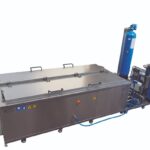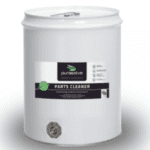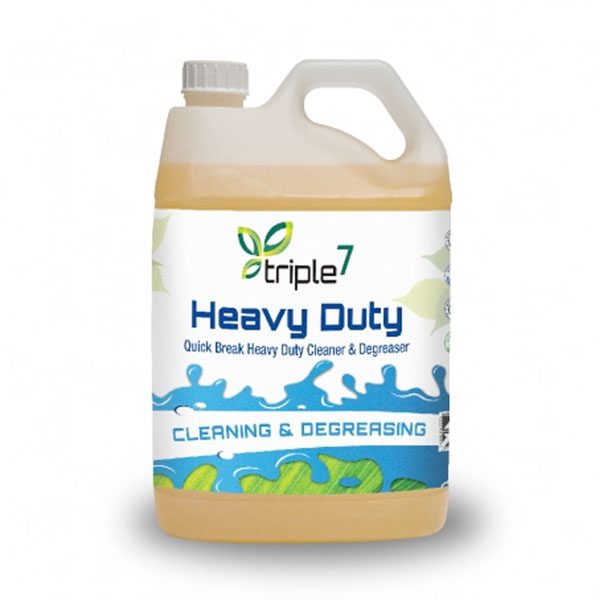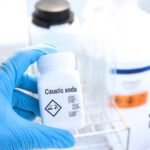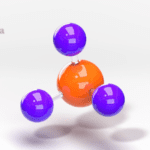Table of Contents
Impact of Caustic Soda Replacement on Industrial Cleaning
In pursuing sustainable industrial practices, the demand for alternatives to traditional cleaning chemicals is rising. Caustic soda, though effective, poses risks due to its corrosiveness, toxicity, and environmental impact. Fortunately, a new era of caustic soda replacements is emerging, prioritising safety, sustainability, and performance.
Evergreen Solution & Products (ESP), a champion of eco-conscious solutions, introduces cutting-edge products poised to transform industrial cleaning. Our alternatives not only provide effective cleaning and degreasing solutions but also demonstrate a strong commitment to environmental well-being. In this blog, we explore the pros & cons of these caustic soda replacements and their impact on +industrial cleaning. Join us on this eco-friendly journey toward a cleaner, greener future.
Borax
Borax (Sodium tetraborate) is considered to be a biobased cleaning chemical because it is a natural mineral that is mined from the earth and does not rely on fossil fuels for its production. It is also considered non-toxic and non-corrosive, but it should be handled with care as it may cause skin irritation if it comes into contact with the skin or eyes. It is also not suitable for consumption.
Advantages of using borax as a caustic soda replacement include:
- Biobased and Sustainable: Borax is a biobased cleaning chemical derived from natural mineral sources, making it an eco-friendly choice.
- Non-Toxic and Non-Corrosive: Borax is generally non-toxic and non-corrosive, reducing health and safety concerns compared to caustic soda.
- Effective Cleaning: It is effective in various cleaning applications, from laundry detergents to household cleaning.
- Multiple Uses: Borax has versatile applications, including stain removal, cleaning, and as laundry booster.
Disadvantages of using borax as a caustic soda replacement include:
- Skin Irritation: Borax may cause skin irritation upon contact, requiring careful handling and protective measures.
- Not for Consumption: Borax is unsuitable for consumption and must be kept away from food items.
- Limited Strength: It may not be as potent or effective as caustic soda in some heavy-duty industrial cleaning tasks.
- Environmental Impact: While less harmful than caustic soda, the ecological impact of borax mining and production should be considered.


Potassium Hydroxide
Potassium hydroxide (KOH) is a strong base that can be used as a replacement for caustic soda (sodium hydroxide) in many industrial processes. It is considered to be a biobased cleaning chemical and an eco-friendly alternative to caustic soda because it is derived from potassium, which is a natural mineral that is abundant in the earth’s crust. Additionally, the manufacturing process of potassium hydroxide is relatively simple and does not generate significant amounts of waste or pollution.
Advantages of using potassium hydroxide as a caustic soda replacement include:
- Lower reactivity: Potassium hydroxide is less reactive than caustic soda, which means it is less likely to cause skin burns or other injuries if it comes into contact with the skin.
- Lower corrosivity: Potassium hydroxide is less corrosive than caustic soda, which means that it is less likely to cause damage to equipment or structures that it comes into contact with.
- Biodegradable: Potassium hydroxide is a biodegradable degreaser, meaning environmental microorganisms can break it down.
- Non-Toxic: Potassium hydroxide is considered to be non-toxic, which means that it is less likely to cause harm to humans and animals if it is released into the environment.
Disadvantages of using potassium hydroxide as a caustic soda replacement include:
- Higher cost: Potassium hydroxide is typically more expensive than caustic soda, making it less cost-effective in some applications.
- Less solubility: Potassium hydroxide is less soluble in water than caustic soda, making it more difficult to dissolve and use in certain applications.
- Reduced effectiveness: Potassium hydroxide may be less effective than caustic soda in some applications, such as producing certain types of soaps and detergents.
Amines


Amines, such as monoethanolamine (MEA) and diethanolamine (DEA), are organic compounds that can be used as alternatives to caustic soda in producing soaps and detergents. They are considered safer and more environmentally friendly options because they are less corrosive, less toxic and a biodegradable degreaser.
Advantages of using amines, such as MEA and DEA, as a caustic soda replacement include:
- Lower corrosivity: Amines are less corrosive than caustic soda, which means that they are less likely to cause damage to equipment or structures that they come into contact with.
- Lower toxicity: Amines are considered to be less toxic than caustic soda, which means that they are less likely to cause harm to humans and animals if they are released into the environment.
- Biodegradable: Amines are biodegradable degreasers, meaning environmental microorganisms can break them down.
- High effectiveness: Amines such as MEA and DEA are effective in cleaning and removing dirt and stains from fabrics.
- Low foaming: Amines, such as DEA, have common foaming properties, which are suitable for some industrial applications that require soft foam.
Disadvantages of using amines, such as MEA and DEA, as a caustic soda replacement include:
- Higher cost: Amines are typically more expensive than caustic soda, making them less cost-effective in some applications.
- Volatility: Amines are volatile, which means that they can easily evaporate, which can make them less efficient in some applications.
- Environmental concerns: Amines such as MEA and DEA are harmful to aquatic life and may contribute to the formation of nitrosamines, which are known carcinogens.
Other amine derivatives, such as Ethylenediamine (EDA) and Triethanolamine (TEA), can also be used as alternatives to caustic soda in producing soaps and detergents. EDA is a less toxic and less corrosive alternative to caustic soda, but it is not biodegradable. TEA is a biodegradable alternative, but it’s more corrosive and toxic than other amines
Sodium percarbonate
Sodium percarbonate is a chemical compound that is a readily biodegradable degreasing alternative to many traditional cleaning chemicals. It is a white, crystalline powder with hydrogen peroxide and sodium carbonate. It is known for its powerful oxygen-based cleaning properties and can be used in a wide range of cleaning applications, but it also has some limitations and areas where it should be avoided.
Advantages of using sodium percarbonate as a caustic soda replacement include:
- Readily biodegradable: Sodium percarbonate is readily biodegradable, meaning environmental microorganisms can break it down. It makes it a more environmentally friendly alternative to many traditional cleaning chemicals that can harm the environment.
- Non-toxic: Sodium percarbonate is considered to be non-toxic, which means that it is less likely to cause harm to humans and animals if it is released into the environment.
- Versatile: Sodium percarbonate can be used in various cleaning applications, including laundry detergent, dishwashing detergent, and general cleaning products. It can be used for cleaning and removing dirt, stains and odours from surfaces, fabrics, and even teeth.
- Oxygen-based cleaning: Sodium percarbonate releases oxygen when it comes into contact with water, which helps to break down and remove dirt, stains, and odours.
- Safe for coloured clothes: Sodium percarbonate is a safe alternative as it does not bleach or discolour the fabric.
Disadvantages of using sodium percarbonate as a caustic soda replacement include:
- Cost: Sodium percarbonate is typically more expensive than traditional cleaning chemicals, making it less cost-effective in some applications.
- Ineffective in hard water: Sodium percarbonate may be less effective in hard water areas as the minerals in the hard water can reduce the effectiveness of the oxygen-cleaning action.
- pH sensitivity: Sodium percarbonate is pH sensitive; it works best at neutral pH, therefore
Sodium lauryl ether sulfate (SLES)
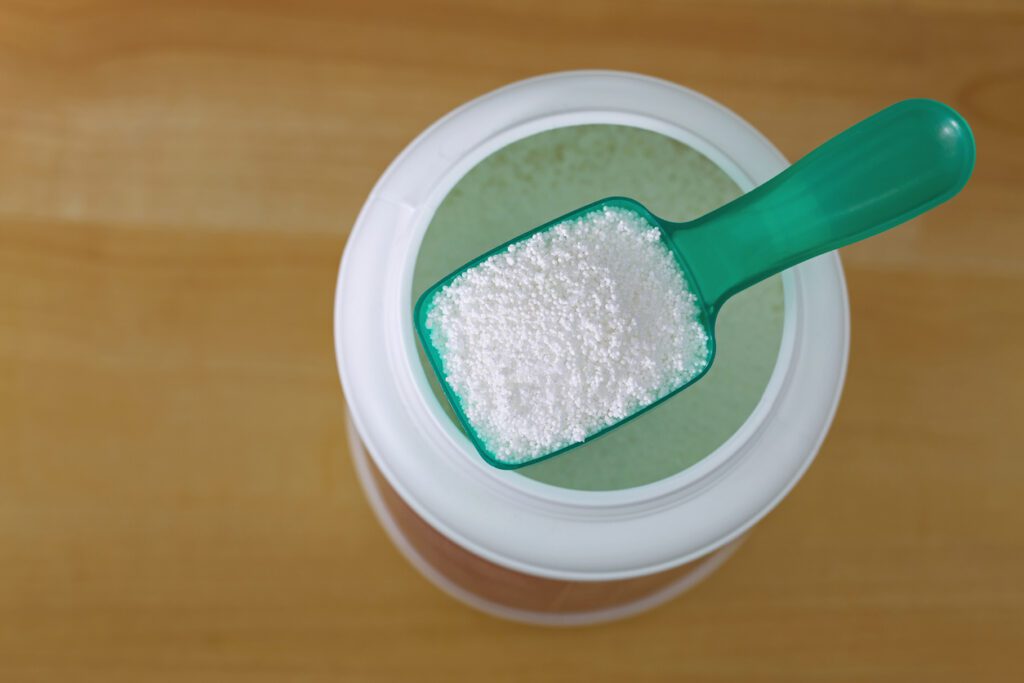

Sodium lauryl ether sulfate (SLES) and sodium lauryl sulfate (SLS) are surfactants commonly used in cleaning products such as soaps, shampoos, and detergents. While they are often considered to be biobased alternatives to caustic soda, they do have some limitations and potential drawbacks.
Advantages of using SLES and SLS as a caustic soda replacement include:
- Biobased: SLES and SLS are both derived from natural sources such as coconut oil or palm kernel oil, which makes them bio-based cleaning chemicals to some traditional cleaning chemicals.
- Effective cleaning agents: Both SLES and SLS are effective cleaning agents that can be used to remove dirt, grease, and other impurities from surfaces and fabrics.
- Low toxicity: SLES and SLS are considered to be low-toxicity chemicals, which means that they are less likely to cause harm to humans and animals if they are released into the environment.
- Readily biodegradable: Both SLES and SLS are readily biodegradable degreasers, which means that microorganisms in the environment can break them down.
Disadvantages of using SLES and SLS as a caustic soda replacement include:
- Environmental concerns: While SLES and SLS are bio-based cleaning chemicals, the raw materials used to produce them (coconut oil or palm kernel oil) may be sourced from regions with controversial environmental and ethical standards.
- Irritation: SLES and SLS can cause skin and eye irritation, as well as scalp irritation, in the case of shampoos and soaps.
- Ineffective in hard water: SLES and SLS may be less effective in hard water areas as the minerals in the hard water can reduce the effectiveness of the cleaning action.
- Biodegradable but not environmentally friendly: While both SLES and SLS are readily biodegradable, they can still have negative impacts on the environment if they are released in large quantities.
Overall, SLES and SLS are biobased alternatives to caustic soda, but they have limitations. They are readily biodegradable and less toxic, but they may cause irritation and not be as effective in hard water areas. They should be used cautiously, especially in products that will be used in large quantities. In general, it’s recommended to choose products that are certified as environmentally friendly and to avoid products that contain SLS and SLES.
ESP’s Caustic Soda Replacement in Industrial Cleaning
ESP is proud to offer a range of green alternatives to caustic soda, featuring Triple7 Aircraft & Metal Cleaner, Triple7 Heavy Duty Degreaser & Cleaner, and Triple7 Mega Clean. These products are designed to deliver effective cleaning and degreasing solutions while strongly emphasising safety and sustainability. For industries in search of eco-conscious options without sacrificing performance, these products are the answer.
Overall
As sustainability gains importance, alternatives to traditional cleaning chemicals are in demand. Caustic soda, with its risks and environmental issues, faces competition from eco-conscious caustic soda replacements. ESP leads this revolution with effective, environmentally committed solutions.
Join us in making a positive change for your industrial cleaning needs. Make the switch to a cleaner, greener future with ESP.
FAQ
What are the advantages of using borax as a caustic soda replacement?
Using borax as a caustic soda replacement offers eco-friendly benefits. Borax is biobased and sustainable, non-toxic, and non-corrosive.
Are there any environmental concerns associated with amines as caustic soda replacements?
Amines, such as MEA and DEA, are safer alternatives to caustic soda. However, they may have environmental concerns due to their harmful effects on aquatic life.
How does sodium percarbonate compare to traditional cleaning chemicals in terms of cost?
Sodium percarbonate’s eco-friendly properties may outweigh the cost difference in applications prioritising sustainability.
What are the potential drawbacks of using SLES and SLS as alternatives to caustic soda?
While SLES and SLS are biobased, they can cause skin and eye irritation. They might be less effective in hard water areas and, in large quantities, can have negative environmental impacts.
Which ESP product is recommended for effective and eco-conscious industrial cleaning?
ESP recommends its Triple7 product line, which includes Triple7 Aircraft & Metal Cleaner, Triple7 Heavy Duty Degreaser & Cleaner, and Triple7 Mega Clean.

